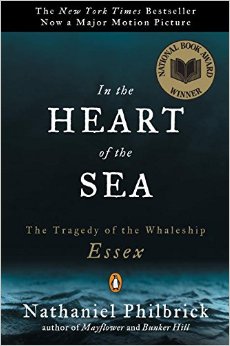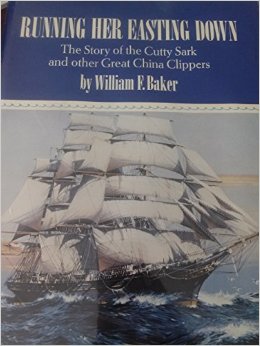 This review comes some fifteen years after the book was originally published. I picked it up recently both because of my interest in the nautical goings on of the early 1800s, (and because of the movie, review here).
This review comes some fifteen years after the book was originally published. I picked it up recently both because of my interest in the nautical goings on of the early 1800s, (and because of the movie, review here).
In the Heart of the Sea follows the true story of the infamous ship-ramming whale that inspired Herman Melville’s classic, Moby Dick, as well as the whalers-turned-prey who, after surviving the initial attack, had to keep themselves alive for another three months on the open ocean before being rescued.
Author Nathaniel Philbrick, does a fantastic job setting up this story. He elucidates the connections to Melville, the economic/religious/and cultural factors at play on the island of Nantucket, and the business of whaling, all with concise, simple explanation. As someone who periodically attempts to write about nautical history, I most appreciate Philbrick’s extraordinary restraint in wielding maritime terminology. He seasons the text with just enough so that a reader with no prior experience is intrigued, not overwhelmed.
Yet, Philbrick is also florid and arresting with his descriptions and juxtapositions. This passage, for example, describes how the Essex recovered from being blown onto her side during a storm early in the voyage:
The rain poured down and the lightning flashed, and time slowed to a crawl as the men clung to the weather rail. But before the axes came into play, the ship twitched back to life. The men could feel it in their hands and feet and in the pits of their stomachs—an easing of the awful strain. They waited for another gust to slam the ship back down again. But no—the ballast continued to exert its gravitational pull, lifting the three masts until the yards came clear of the water. As the masts swung into the sky, seawater rushed across the deck and out the scuppers. The Essex shuddered to the vertical and was a ship again. (page 41)
Philbrick adds to the scholarship of whaling and the public understanding of the Essex saga by drawing chiefly on the recently discovered account of the voyage by a teenage crew member named Nickerson. The author uses Nickerson’s story to contrast earlier retellings, showing the same events from a slightly different angle, corroborating some details, challenging others. Apart from this, Philbrick also uses compatible data to fill in gaps and gray areas in the narrative. He draws on the logs of other ships in the area, World War Two hunger studies, as well as documented cases of and reactions to cannibalism, dehydration, and malnutrition.
In the Heart of the Sea does more than simply retell the story of the Essex, it attempts to analyze and comment on it as well. Philbrick pays special attention to the clickishness of the Nantucketers both before and after the attack, the way they stuck together throughout the ordeal of surviving on the open ocean. Particularly worrying is the order in which the men who died or were cannibalized once food stores began to run low. The African-American crew members were the first to be eaten.
Philbrick dwells on how quickly the veneer of Quakerism melted away in the face of the unspeakable horrors the men experienced at sea, as well as how the community back home struggled to cope with the reality of what they had done once they returned.
In the Heart of the Sea is probably the most comprehensive-yet-accessible book that could possibly be written about this topic. It strikes perfect tone between academic rigor, seamanly bona fides, and readability for a general audience. There is nothing more to ask.
For more reviews follow me on Goodreads.
Interested in the 19th Century Tea Clipper Races? Follow Cutty Sark Log on Twitter.










